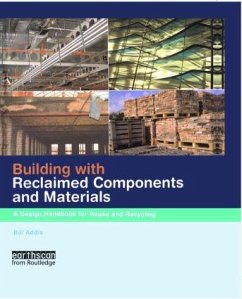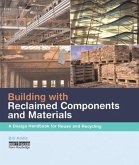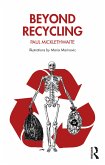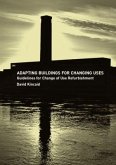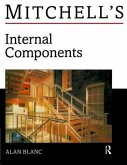- Gebundenes Buch
- Merkliste
- Auf die Merkliste
- Bewerten Bewerten
- Teilen
- Produkt teilen
- Produkterinnerung
- Produkterinnerung
Identifies how building designers and constructors can minimize the generation of waste at the design stage of a building project by using reclaimed components and materials. This book highlights the opportunities for using reclaimed components and materials and recycled-content building products for these elements of a building.
Andere Kunden interessierten sich auch für
![Building with Reclaimed Components and Materials Building with Reclaimed Components and Materials]() Bill AddisBuilding with Reclaimed Components and Materials51,99 €
Bill AddisBuilding with Reclaimed Components and Materials51,99 €![Beyond Recycling Beyond Recycling]() Paul MicklethwaiteBeyond Recycling25,99 €
Paul MicklethwaiteBeyond Recycling25,99 €![Structural Engineer's Pocket Book: Eurocodes Structural Engineer's Pocket Book: Eurocodes]() Fiona CobbStructural Engineer's Pocket Book: Eurocodes58,99 €
Fiona CobbStructural Engineer's Pocket Book: Eurocodes58,99 €![Adapting Buildings for Changing Uses Adapting Buildings for Changing Uses]() David KincaidAdapting Buildings for Changing Uses118,99 €
David KincaidAdapting Buildings for Changing Uses118,99 €![Procurement in the Construction Industry Procurement in the Construction Industry]() William Hughes (UK University of Reading)Procurement in the Construction Industry62,99 €
William Hughes (UK University of Reading)Procurement in the Construction Industry62,99 €![Internal Components Internal Components]() Alan BlancInternal Components92,99 €
Alan BlancInternal Components92,99 €![Design Technology in Contemporary Architectural Practice Design Technology in Contemporary Architectural Practice]() Dominik Holzer (Australia University of Melbourne)Design Technology in Contemporary Architectural Practice49,99 €
Dominik Holzer (Australia University of Melbourne)Design Technology in Contemporary Architectural Practice49,99 €-
-
-
Identifies how building designers and constructors can minimize the generation of waste at the design stage of a building project by using reclaimed components and materials. This book highlights the opportunities for using reclaimed components and materials and recycled-content building products for these elements of a building.
Produktdetails
- Produktdetails
- Verlag: Taylor & Francis Ltd
- Seitenzahl: 224
- Erscheinungstermin: 1. Mai 2006
- Englisch
- Abmessung: 258mm x 217mm x 20mm
- Gewicht: 710g
- ISBN-13: 9781844072743
- ISBN-10: 1844072746
- Artikelnr.: 23191811
- Herstellerkennzeichnung
- Libri GmbH
- Europaallee 1
- 36244 Bad Hersfeld
- gpsr@libri.de
- Verlag: Taylor & Francis Ltd
- Seitenzahl: 224
- Erscheinungstermin: 1. Mai 2006
- Englisch
- Abmessung: 258mm x 217mm x 20mm
- Gewicht: 710g
- ISBN-13: 9781844072743
- ISBN-10: 1844072746
- Artikelnr.: 23191811
- Herstellerkennzeichnung
- Libri GmbH
- Europaallee 1
- 36244 Bad Hersfeld
- gpsr@libri.de
Bill Addis leads the sustainability team at Buro Happold Consulting Engineers, UK. The research for this book was carried out by staff in Buro Happold and the Building Services Research and Information Association (BSRIA), under the guidance of a consortium of partners in industry and academia, with financial support from the UK Government Department of Trade and Industry.
Introduction
Part I: The World of Reclamation, Reuse and Recycling
Why do it?
Reclamation, reuse and recycling are not new ideas
The basic concepts of reclamation, reuse and recycling
The reuse and recycling market place
Part II: Case Studies of Reuse and Recycling
Swedish student accommodation made from reclaimed materials
BedZED, London, UK
The C.K. Choi Building, University of British Columbia, Canada
The reclaimed vicarage, Birmingham, UK
Using recycled-content building products in the US
BRE Building 16: The 'energy-efficient office of the future', Garston, UK
The Earth Centre, Sheffield, UK
Westborough School, Southend, UK
Canalside West, Huddersfield, UK
Reusing structural steelwork
Fitout of Duchi shoe shop, Scheveningen, Netherlands
Part III: Making Reclamation, Reuse and Recycling Happen
Not the 'usual' approach to design and procurement
Decision-making
Opportunities for reuse and recycling
Seeking and finding the buildings, goods and materials
Ensuring reclamation, reuse and recycling happens
Part IV: Design Guidance: Foundations and Retaining Structures
Building foundations
Reuse of foundations in situ
Use of reclaimed products and materials
Recycled-content building products
Case studies
Part V: Design Guidance: Building Structure
Reuse, reclamation and recycling in the structure of buildings
Masonry (load-bearing and non-load-bearing)
Structural frame: Timber
Structural frame: Iron and steel
Structural frame: In situ concrete and pre-cast concrete
Floors in the structural frame
Part VI: Design Guidance: Building Envelope
Reclamation, reuse and recycling in the building envelope
Cladding systems
Roofing
Waterproofing
Case studies: Fa ade reuse and refurbishment
Part VII: Design Guidance: Enclosure, Interiors and External Works
Space enclosure: Partitions, insulation, ceilings, raised floors
Windows
Doors
Stairs and balustrades
Surface finishes/floor coverings
Furniture and equipment
Sanitary, laundry and cleaning equipment
External works
Part VIII: Design Guidance: Mechanical and Electrical Services
Mechanical and electrical services
Mechanical heating/cooling/refrigeration systems
Ventilation and air-conditioning systems
Piped supply and disposal systems
Electrical supply, power and lighting systems
Information and communications products
Lifts and escalators
Part I: The World of Reclamation, Reuse and Recycling
Why do it?
Reclamation, reuse and recycling are not new ideas
The basic concepts of reclamation, reuse and recycling
The reuse and recycling market place
Part II: Case Studies of Reuse and Recycling
Swedish student accommodation made from reclaimed materials
BedZED, London, UK
The C.K. Choi Building, University of British Columbia, Canada
The reclaimed vicarage, Birmingham, UK
Using recycled-content building products in the US
BRE Building 16: The 'energy-efficient office of the future', Garston, UK
The Earth Centre, Sheffield, UK
Westborough School, Southend, UK
Canalside West, Huddersfield, UK
Reusing structural steelwork
Fitout of Duchi shoe shop, Scheveningen, Netherlands
Part III: Making Reclamation, Reuse and Recycling Happen
Not the 'usual' approach to design and procurement
Decision-making
Opportunities for reuse and recycling
Seeking and finding the buildings, goods and materials
Ensuring reclamation, reuse and recycling happens
Part IV: Design Guidance: Foundations and Retaining Structures
Building foundations
Reuse of foundations in situ
Use of reclaimed products and materials
Recycled-content building products
Case studies
Part V: Design Guidance: Building Structure
Reuse, reclamation and recycling in the structure of buildings
Masonry (load-bearing and non-load-bearing)
Structural frame: Timber
Structural frame: Iron and steel
Structural frame: In situ concrete and pre-cast concrete
Floors in the structural frame
Part VI: Design Guidance: Building Envelope
Reclamation, reuse and recycling in the building envelope
Cladding systems
Roofing
Waterproofing
Case studies: Fa ade reuse and refurbishment
Part VII: Design Guidance: Enclosure, Interiors and External Works
Space enclosure: Partitions, insulation, ceilings, raised floors
Windows
Doors
Stairs and balustrades
Surface finishes/floor coverings
Furniture and equipment
Sanitary, laundry and cleaning equipment
External works
Part VIII: Design Guidance: Mechanical and Electrical Services
Mechanical and electrical services
Mechanical heating/cooling/refrigeration systems
Ventilation and air-conditioning systems
Piped supply and disposal systems
Electrical supply, power and lighting systems
Information and communications products
Lifts and escalators
Introduction * Part I: The World of Reclamation, Reuse and Recycling * Why do it? * Reclamation, reuse and recycling are not new ideas * The basic concepts of reclamation, reuse and recycling * The reuse and recycling market place * Part II: Case Studies of Reuse and Recycling * Swedish student accommodation made from reclaimed materials * BedZED, London, UK * The C.K. Choi Building, University of British Columbia, Canada * The reclaimed vicarage, Birmingham, UK * Using recycled-content building products in the US * BRE Building 16: The 'energy-efficient office of the future', Garston, UK * The Earth Centre, Sheffield, UK * Westborough School, Southend, UK * Canalside West, Huddersfield, UK * Reusing structural steelwork * Fitout of Duchi shoe shop, Scheveningen, Netherlands * Part III: Making Reclamation, Reuse and Recycling Happen * Not the 'usual' approach to design and procurement * Decision-making * Opportunities for reuse and recycling * Seeking and finding the buildings, goods and materials * Ensuring reclamation, reuse and recycling happens * Part IV: Design Guidance: Foundations and Retaining Structures * Building foundations * Reuse of foundations in situ * Use of reclaimed products and materials * Recycled-content building products * Case studies * Part V: Design Guidance: Building Structure * Reuse, reclamation and recycling in the structure of buildings * Masonry (load-bearing and non-load-bearing) * Structural frame: Timber * Structural frame: Iron and steel * Structural frame: In situ concrete and pre-cast concrete * Floors in the structural frame * Part VI: Design Guidance: Building Envelope * Reclamation, reuse and recycling in the building envelope * Cladding systems * Roofing * Waterproofing * Case studies: Fa ade reuse and refurbishment * Part VII: Design Guidance: Enclosure, Interiors and External Works * Space enclosure: Partitions, insulation, ceilings, raised floors * Windows * Doors * Stairs and balustrades * Surface finishes/floor coverings * Furniture and equipment * Sanitary, laundry and cleaning equipment * External works * Part VIII: Design Guidance: Mechanical and Electrical Services * Mechanical and electrical services * Mechanical heating/cooling/refrigeration systems * Ventilation and air-conditioning systems * Piped supply and disposal systems * Electrical supply, power and lighting systems * Information and communications products * Lifts and escalators *
Introduction
Part I: The World of Reclamation, Reuse and Recycling
Why do it?
Reclamation, reuse and recycling are not new ideas
The basic concepts of reclamation, reuse and recycling
The reuse and recycling market place
Part II: Case Studies of Reuse and Recycling
Swedish student accommodation made from reclaimed materials
BedZED, London, UK
The C.K. Choi Building, University of British Columbia, Canada
The reclaimed vicarage, Birmingham, UK
Using recycled-content building products in the US
BRE Building 16: The 'energy-efficient office of the future', Garston, UK
The Earth Centre, Sheffield, UK
Westborough School, Southend, UK
Canalside West, Huddersfield, UK
Reusing structural steelwork
Fitout of Duchi shoe shop, Scheveningen, Netherlands
Part III: Making Reclamation, Reuse and Recycling Happen
Not the 'usual' approach to design and procurement
Decision-making
Opportunities for reuse and recycling
Seeking and finding the buildings, goods and materials
Ensuring reclamation, reuse and recycling happens
Part IV: Design Guidance: Foundations and Retaining Structures
Building foundations
Reuse of foundations in situ
Use of reclaimed products and materials
Recycled-content building products
Case studies
Part V: Design Guidance: Building Structure
Reuse, reclamation and recycling in the structure of buildings
Masonry (load-bearing and non-load-bearing)
Structural frame: Timber
Structural frame: Iron and steel
Structural frame: In situ concrete and pre-cast concrete
Floors in the structural frame
Part VI: Design Guidance: Building Envelope
Reclamation, reuse and recycling in the building envelope
Cladding systems
Roofing
Waterproofing
Case studies: Fa ade reuse and refurbishment
Part VII: Design Guidance: Enclosure, Interiors and External Works
Space enclosure: Partitions, insulation, ceilings, raised floors
Windows
Doors
Stairs and balustrades
Surface finishes/floor coverings
Furniture and equipment
Sanitary, laundry and cleaning equipment
External works
Part VIII: Design Guidance: Mechanical and Electrical Services
Mechanical and electrical services
Mechanical heating/cooling/refrigeration systems
Ventilation and air-conditioning systems
Piped supply and disposal systems
Electrical supply, power and lighting systems
Information and communications products
Lifts and escalators
Part I: The World of Reclamation, Reuse and Recycling
Why do it?
Reclamation, reuse and recycling are not new ideas
The basic concepts of reclamation, reuse and recycling
The reuse and recycling market place
Part II: Case Studies of Reuse and Recycling
Swedish student accommodation made from reclaimed materials
BedZED, London, UK
The C.K. Choi Building, University of British Columbia, Canada
The reclaimed vicarage, Birmingham, UK
Using recycled-content building products in the US
BRE Building 16: The 'energy-efficient office of the future', Garston, UK
The Earth Centre, Sheffield, UK
Westborough School, Southend, UK
Canalside West, Huddersfield, UK
Reusing structural steelwork
Fitout of Duchi shoe shop, Scheveningen, Netherlands
Part III: Making Reclamation, Reuse and Recycling Happen
Not the 'usual' approach to design and procurement
Decision-making
Opportunities for reuse and recycling
Seeking and finding the buildings, goods and materials
Ensuring reclamation, reuse and recycling happens
Part IV: Design Guidance: Foundations and Retaining Structures
Building foundations
Reuse of foundations in situ
Use of reclaimed products and materials
Recycled-content building products
Case studies
Part V: Design Guidance: Building Structure
Reuse, reclamation and recycling in the structure of buildings
Masonry (load-bearing and non-load-bearing)
Structural frame: Timber
Structural frame: Iron and steel
Structural frame: In situ concrete and pre-cast concrete
Floors in the structural frame
Part VI: Design Guidance: Building Envelope
Reclamation, reuse and recycling in the building envelope
Cladding systems
Roofing
Waterproofing
Case studies: Fa ade reuse and refurbishment
Part VII: Design Guidance: Enclosure, Interiors and External Works
Space enclosure: Partitions, insulation, ceilings, raised floors
Windows
Doors
Stairs and balustrades
Surface finishes/floor coverings
Furniture and equipment
Sanitary, laundry and cleaning equipment
External works
Part VIII: Design Guidance: Mechanical and Electrical Services
Mechanical and electrical services
Mechanical heating/cooling/refrigeration systems
Ventilation and air-conditioning systems
Piped supply and disposal systems
Electrical supply, power and lighting systems
Information and communications products
Lifts and escalators
Introduction * Part I: The World of Reclamation, Reuse and Recycling * Why do it? * Reclamation, reuse and recycling are not new ideas * The basic concepts of reclamation, reuse and recycling * The reuse and recycling market place * Part II: Case Studies of Reuse and Recycling * Swedish student accommodation made from reclaimed materials * BedZED, London, UK * The C.K. Choi Building, University of British Columbia, Canada * The reclaimed vicarage, Birmingham, UK * Using recycled-content building products in the US * BRE Building 16: The 'energy-efficient office of the future', Garston, UK * The Earth Centre, Sheffield, UK * Westborough School, Southend, UK * Canalside West, Huddersfield, UK * Reusing structural steelwork * Fitout of Duchi shoe shop, Scheveningen, Netherlands * Part III: Making Reclamation, Reuse and Recycling Happen * Not the 'usual' approach to design and procurement * Decision-making * Opportunities for reuse and recycling * Seeking and finding the buildings, goods and materials * Ensuring reclamation, reuse and recycling happens * Part IV: Design Guidance: Foundations and Retaining Structures * Building foundations * Reuse of foundations in situ * Use of reclaimed products and materials * Recycled-content building products * Case studies * Part V: Design Guidance: Building Structure * Reuse, reclamation and recycling in the structure of buildings * Masonry (load-bearing and non-load-bearing) * Structural frame: Timber * Structural frame: Iron and steel * Structural frame: In situ concrete and pre-cast concrete * Floors in the structural frame * Part VI: Design Guidance: Building Envelope * Reclamation, reuse and recycling in the building envelope * Cladding systems * Roofing * Waterproofing * Case studies: Fa ade reuse and refurbishment * Part VII: Design Guidance: Enclosure, Interiors and External Works * Space enclosure: Partitions, insulation, ceilings, raised floors * Windows * Doors * Stairs and balustrades * Surface finishes/floor coverings * Furniture and equipment * Sanitary, laundry and cleaning equipment * External works * Part VIII: Design Guidance: Mechanical and Electrical Services * Mechanical and electrical services * Mechanical heating/cooling/refrigeration systems * Ventilation and air-conditioning systems * Piped supply and disposal systems * Electrical supply, power and lighting systems * Information and communications products * Lifts and escalators *
'Expert advice on reuse and recycling in building construction is urgently needed. Using existing resources in a more responsible way is central to this design guide. A very welcome addition to the literature'Tom Woolley, Professor of Architecture, Queens University Belfast, and author of the acclaimed Green Building Handbook'The message from this book is that if you have the time and inclination then it is possible to source, check and incorporate reused materials into your buildings.'Ecotech

